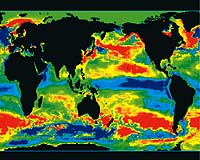| . |  |
. |
San Diego CA (SPX) Sep 02, 2009 Scientists have just completed an unprecedented journey into the vast and little-explored "Great Pacific Ocean Garbage Patch." On the Scripps Environmental Accumulation of Plastic Expedition (SEAPLEX), researchers got the first detailed view of plastic debris floating in a remote ocean region. It wasn't a pretty sight. The Scripps research vessel (R/V) New Horizon left its San Diego homeport on August 2, 2009, for the North Pacific Ocean Gyre, located some 1,000 miles off California's coast, and returned on August 21, 2009. Scientists surveyed plastic distribution and abundance, taking samples for analysis in the lab and assessing the impacts of debris on marine life. Before this research, little was known about the size of the "garbage patch" and the threats it poses to marine life and the gyre's biological environment. The expedition was led by a team of Scripps Institution of Oceanography (SIO) graduate students, with support from University of California Ship Funds, the National Science Foundation (NSF) and Project Kaisei. "SEAPLEX was an important education experience for the graduate students, and contributed to a better understanding of an important problem in the oceans," said Linda Goad, program director in NSF's Division of Ocean Sciences. "We hope that SEAPLEX will result in increased awareness of a growing issue." After transiting for six days aboard the research vessel, the researchers reached their first intensive sampling site on August 9th. Team members began 24-hour sampling periods using a variety of tow nets to collect debris at several ocean depths. "We targeted the highest plastic-containing areas so we could begin to understand the scope of the problem," said Miriam Goldstein of SIO, chief scientist of the expedition. "We also studied everything from phytoplankton to zooplankton to small midwater fish." The scientists found that at numerous areas in the gyre, flecks of plastic were abundant and easily spotted against the deep blue seawater. Among the assortment of items retrieved were plastic bottles with a variety of biological inhabitants. The scientists also collected jellyfish called by-the-wind sailors (Velella velella). On August 11th, the researchers encountered a large net entwined with plastic and various marine organisms; they also recovered several plastic bottles covered with ocean animals, including large barnacles. The next day, Pete Davison, an SIO graduate student studying mid-water fish, collected several species in the gyre, including the pearleye (Benthalbella dentata), a predatory fish with eyes that look upward so it can see prey swimming above, and lanternfish (Tarletonbeania crenularis), which migrate from as deep as 700 meters down to the ocean surface each day. By the end of the expedition, the researchers were intrigued by the gyre, but had seen their fill of its trash. "Finding so much plastic there was shocking," said Goldstein. "How could there be this much plastic floating in a random patch of ocean--a thousand miles from land?" Share This Article With Planet Earth
Related Links Scripps Environmental Accumulation of Plastic Expedition (SEAPLEX) National Science Foundation Water News - Science, Technology and Politics
 Warming Ocean Contributes To Global Warming
Warming Ocean Contributes To Global WarmingSouthampton, UK (SPX) Aug 21, 2009 The warming of an Arctic current over the last 30 years has triggered the release of methane, a potent greenhouse gas, from methane hydrate stored in the sediment beneath the seabed. Scientists at the National Oceanography Centre Southampton working in collaboration with researchers from the University of Birmingham, Royal Holloway London and IFM-Geomar in Germany have found that more than ... read more |
|
| The content herein, unless otherwise known to be public domain, are Copyright 1995-2009 - SpaceDaily. AFP and UPI Wire Stories are copyright Agence France-Presse and United Press International. ESA Portal Reports are copyright European Space Agency. All NASA sourced material is public domain. Additional copyrights may apply in whole or part to other bona fide parties. Advertising does not imply endorsement,agreement or approval of any opinions, statements or information provided by SpaceDaily on any Web page published or hosted by SpaceDaily. Privacy Statement |